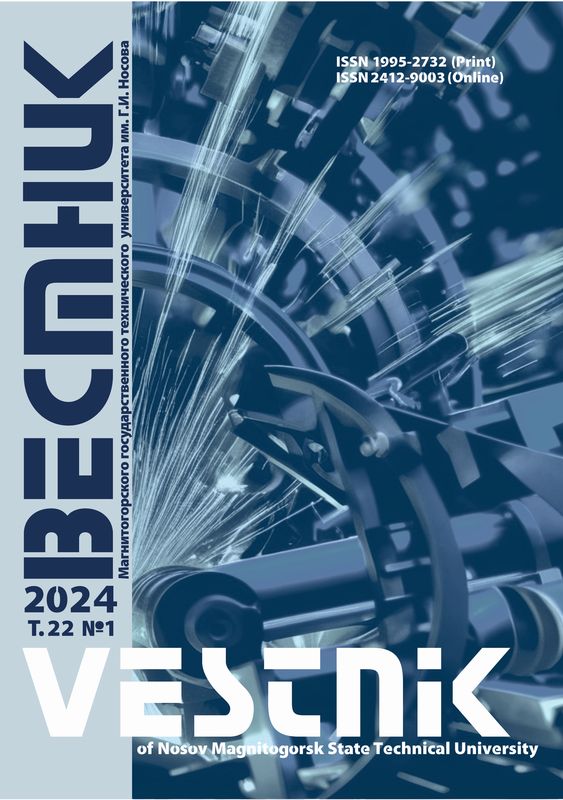Abstract
Thin-walled pipes made of corrosion-resistant steels are widely used in aviation, rocket engineering, space technology, shipbuilding, machine building, ferrous and non-ferrous metallurgy, as well as nuclear power, chemical, oil and gas and other industries. Pipe bending is one of the key processes in the production of pipeline components. During pipe bending and rolling, thermal phenomena dictate the temperature in the bending zone, the wear rate of the tool (rolling balls), and hence its durability. To establish the heat distribution pattern in the bending zone, we conducted a series of natural experiments using an artificial thermocouple and a thermal imager. The artificial thermocouple was used because it is a simple, reliable, and easily available tool. All the necessary measurements were taken on a special pipe bending machine designed for small diameter pipes. All temperatures were recorded using a thermal imager. There were experiments carried out with and without a coolant. To obtain a spatial pattern of heat distribution in the treatment zone and to establish a relationship between the temperature and the bending time and phase, a series of measurements was taken with the industrial thermal imager FLIR P65 on a custom-built machine of the SKhGT-3 model designed at SUSU. Curves were built showing the temperature variations in the rolling zone when 10 points are covered in one time. A comparison was made of two temperature measuring techniques. Temperature was measured in the rolling zone with no coolant used, and temperature was measured at the pipe surface, which noticeably differs from the temperature on the rolling tool due to heat dissipation across various components of the process system, the workpiece and the environment. The study found that an extended processing period makes the effect of low-temperature tempering of the tool more probable, which makes the use of highly effective cooling agents a pre-requisite condition.
Keywords
Thermal phenomena, pipe bending, custom-built machine, artificial thermocouple, thermal imager.
1. Kozlov A.V., Bobylev A.V. Tekhnologiya i oborudovanie kholodnoy gibki tonkostennykh trub: monografiya [Technology and equipment for cold bending of thin-walled pipes: Monograph]. Chelyabinsk: SUSU, 2007, 169 p. (In Russ.)
2. Solomonov, K., 2014, Development of software for simulation of forming forgings, Procedia Engineering, 8. P. 437–443.
3. Khlud A.A. Obkatyvanie rolikami naruzhnykh i raskatyvanie sharikami vnutrennikh poverkhnostey. Razmernochistovaya i uprochnyayushchaya obrabotka detaley davleniem [Roller rolling of outer surfaces and ball rolling of internal surfaces. Finishing and hardening treatment of machine parts]. Moscow: Mashinostroenie, 1963, pp. 144–160. (In Russ.)
4. Smirnov-Alyaev G.A. Soprotivlenie materialov plasticheskomu deformirovaniyu [Resistance of materials to plastic deformation]. Moscow; Leningrad: Mashgiz, 1961, 463 p. (In Russ.)
5. LS-DYNA Theoretical Manual. Compiled By John O. Hallquist. 1998. 498 p.
6. Herrmann M. Fiderer M., Walters J. State-of-the-Art in Process Simulation of Forming Processes. Papers of the International Conference “New Developments in Forging Technology” in Fellbach (near Stuttgart). Frankfurt/M.: MAT-INFO Werkstoff-Information-sgesellschaft, 2005. 68 p.
7. Kozlov А., Khilkevich Y. The technology and equipment for cold bending of pipes. The 29th International Conference on Mechanical Engineering: Book of Conference Lecturer. Haifa, Israel: Technion, 2003. P. 190–192.
8. Kozlov A.V. Sherkunov V.G., Kyilcevich Ya.M. Stress state in pipe on flexure with internal shairing. Russian Engineering Reseach. New York: Allerton Press, Inc., 2009, vol. 29, no. 8. P. 809–812.
9. Pesin A., Pustovoytov D. Influence of process parameters on distribution of shear strain through sheet thickness in asymmetric rolling. Key Engineering Materials. Vol. 622–623, 2014, pp. 929–935.
10. Khaliulin E.V., Kozlov A.V. Use of a thermocouple to measure temperature during pipe bending and rolling. Vestnik UGATU. Seriya “Mashinostroenie” [Bulletin of USATU. Series: Mechanical Engineering. Ufa: Publishing House of USATU, 2014, vol. 18, no. 3 (64), pp. 93–96. (In Russ.)
11. Banabic D, Bunge H.J., Pohlandt K. and Tekkaya A.E. (2000), Formability Of Metallic Materials: Plastic Anisotropy, Formability Testing, Forming Limits, Springer, Berlin, Germany.
12. Hosford W.F. Mechanical Behavior of Materials. New-York, Cambridge University Press. 2005.
13. Ling K., Liu Y.-K. Study on forming process of the oil pipe with upset ends. Applied Mechanics and Materials. 2014, vol. 456, pp. 648–651.
14. Veiler S.Ya., Likhtman V.I. Deystvie smazok pri obrabotke metallov davleniem [The effect of lubricants during metal forming]. Moscow: Publishing House of the USSR Academy of Sciences, 1960, 232 p. (In Russ.)
15. Yu Y.-Q. Analysis of the tube head upsetting forming process // Petrochemical Equipment. 2015. Vol. 44. P. 58–63.
16. Kozlov A.V., Bobylev A.V. On the possibility of cold bending of stainless steel and titanium alloy pipes. Otraslevye aspekty tekhnicheskikh nauk [Industry specific aspects of engineering sciences]. Moscow: INGN, 2012, pp. 6–10. (In Russ.)
17. Lux, R., Kletzin, U., Geinitz, V., Beyer, P. Changes in mechanical parameters of stored patented cold-drawn steel wire. Wire Journal International. Vol. 47, iss. 7, July 2014, pp. 78–83.
18. Gaydamak K.M. Montazh oborudovaniya obshchego naznacheniya i tekhnologicheskikh truboprovodov [Installation of general-purpose equipment and process piping]. Moscow: Vysshaya shkola, 1987, 255 p. (In Russ.)
19. Tavastzherna R.I. Izgotovlenie i montazh tekhnologicheskikh truboprovodov [Manufacturing and installation of process piping]. Moscow: Mashinostroenie, 1989, 288 p. (In Russ.)
20. Galperin A.I. Mashiny i oborudovanie dlya gibki trub [Pipe bending machines and equipment]. Moscow: Mashinostroenie, 1983, 203 p. (In Russ.)
21. Kozlov A.V., Sherkunov V.G. Computer modelling of the pipe bending and rolling process. Vestnik TGU [Tomsk State University Journal], 2009, pp. 11–15. (In Russ.)
22. Yuri F. Kurmachev, Ruslan E. Sokolov, Denis S. Voroshilov, Vadim M. Bespalov, Vladimir V. Moscvichev. The analytical dependence of the filling billets value to a given relative degree of deformation during cold rolling of tubes. Journal of Siberian Federal University. 2012 5 (7), pp. 731–736.












